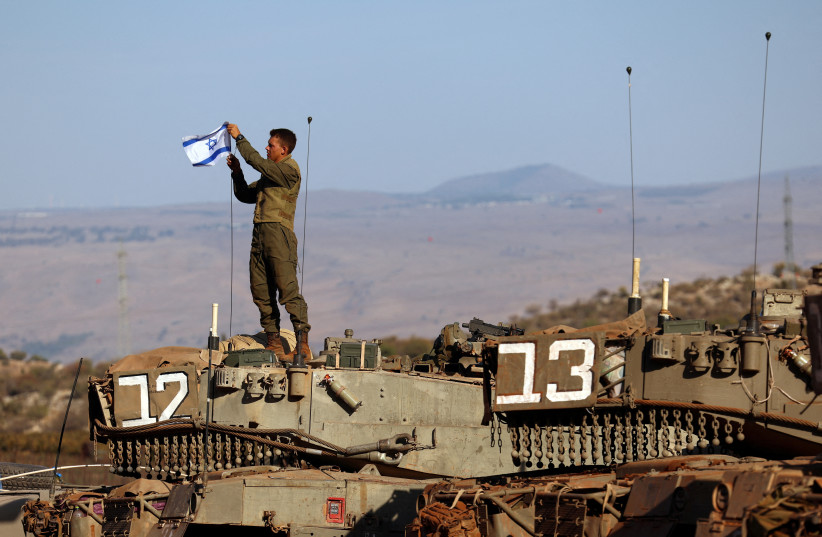War’s natural course, wrote the great military thinker Carl von Clausewitz, is to begin with a defensive and end with an offensive (On War, VI, 1).
Defense, argued the Prussian general, is the stronger form of warfare. That’s also what guided the IDF’s attitude toward Hamas, which – like Clausewitz – combined strategic defense and tactical attack.
As this column did a decade ago (“Who’s afraid of a war of attrition?” August 23, 2014), Israel chose vis-à-vis Hamas a strategy of attrition, much the way Ulysses S. Grant did before defeating Robert E. Lee, and the way Titus did before quelling Judea’s revolt. It’s the prerogative of the side with more people, money, and arms.
This thinking is now dead. The new thinking should be that Israel cannot tolerate a jihadist militia’s presence anywhere along its borders. That is the first of what should be the IDF’s two military lessons and three social demands following the Israel-Gaza war.
The second military lesson is that defensive strategies can exact a dangerous mental price – the price of self-sedation.

Surrounded by cameras, zeppelins, and drones along a tall fence above ground, and a seismic barrier underground, we fell asleep. Our defensive mindset inspired an over-reliance on technology, which then decayed our imagination. That’s why we failed to imagine an enemy with no gunships, jets, or tanks daring, and managing, to deploy thousands of killers by land, sea, and air along a 40-km. front.
Fortunately, the failure of defensive imagination has been offset by the success of the IDF’s tactical offensiveness. Hamas surprised strategically, the IDF surprised tactically.
Unlike some experts’ prewar warnings, the IDF proved battle-ready. Armored brigades, artillery batteries, and infantry battalions proved well trained, their hardware proved well maintained, ground-air cooperation proved impressive, and generals proved inventive.
The IDF’s stealthy emergence in the enemy’s heartland, the steady advance through Gaza’s urban thicket, and the isolation of Hamas’s nerve center by emptying it of the population in which it was deliberately wrapped, all indicate that the IDF’s offensive thinking and preparation were sound.
The military lesson from all this will be to repair the IDF’s defensive operation. Whatever political arrangement emerges in postwar Gaza, the IDF will keep along its border the kind of permanent and sizable force that wasn’t there the morning of October 7.
Similar redeployments will likely happen along the rest of the borders. This will mean restoring men’s regular army service to 36 months from the 32 to which it was reduced last decade, and that will mean raising military spending, which will mean raising taxes.
These purely military lessons will very likely happen. That cannot be said of the three social changes that the IDF should now demand.
The massacre's first social lesson is about communal defense.
The so-called “readiness squads” in the western Negev’s kibbutzim and moshavim fought heroically on October 7 but were woefully understaffed and poorly armed. In my wife, Nurit’s, kibbutz – Sa’ad – the squad comprised six people and six rifles, each with several dozen bullets.
The squad divided the perimeter fence between them, and while hearing Hamas’s guns crackling across the road in Kfar Aza, the squad fended off terrorists who approached their own front gate, and at the same time treated casualties who kept streaming from the dance festival’s killing field.
When some 70 terrorists approached Sa’ad’s other gate, a lone IDF tank emerged out of nowhere and machine-gunned the assailants, killing 20 and chasing away the rest.
It would all have been entirely different had such a community had 50 rifles and several grenades. It’s a kibbutz, for heaven’s sake, full of combat soldiers and officers. There is no reason not to keep an M-16 in every second or third house in such a place, and integrate its men in the army’s regional deployment.
Agricultural weapons
The second social lesson should be about agriculture.
Israel must restore the status that farming once enjoyed here as a Zionist value and strategic asset. The Jewish state’s borders were largely drawn by plowshares and defended by farmers. This changed during the Likud era, which was inspired by Menachem Begin’s disdain for the kibbutzim.
This misunderstanding of agriculture’s Zionist value later produced an effort to deregulate farming and expose it to foreign competition. Consequently, thousands of farmers quit the profession, and farmlands continuously face pressure to become commercial or residential real estate.
This should now change. Farming should be subsidized, and farmland should be sanctified. To maintain our farmers’ grip of our borders, Middle Israelis will readily pay another 10, 20, or 50 shekels for a bag of homegrown vegetables and fruits.
The IDF’s third social demand following this war should be about ultra-Orthodoxy.
The massacre’s shock has sent 2,000 ultra-Orthodox men to the IDF’s recruitment centers, the army reported one week into the war. We want to fight, they said plainly. This is besides the noble role other ultra-Orthodox men played in collecting and identifying the remains of the massacre’s victims.
Now these displays of solidarity can be taken one step further because the IDF should want readiness squads not only in border communities but also in every city and neighborhood.
The IDF should therefore offer to train, build, and deploy ultra-Orthodox readiness squads with the blessing and cooperation of ultra-Orthodox rabbis. Entailing several months’ training and several years of weekly patrol duty, this will be legally defined as an alternative military service, alongside other options like service in fire brigades, police stations, or hospital wards.
Such an arrangement would not be a mere gesture to the state; it would serve a real military need, solve one of the Zionist enterprise’s deepest problems, and while at it help lead us all from trauma to hope.
www.MiddleIsrael.net
The writer, a Hartman Institute fellow, is the author of the bestselling Mitzad Ha’ivelet Ha’yehudi (The Jewish March of Folly, Yediot Sefarim, 2019), a revisionist history of the Jewish people’s political leadership.
